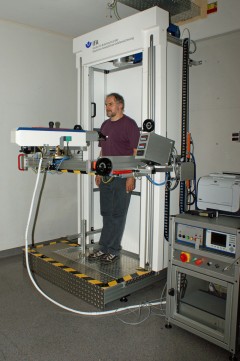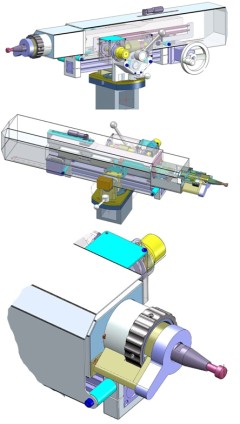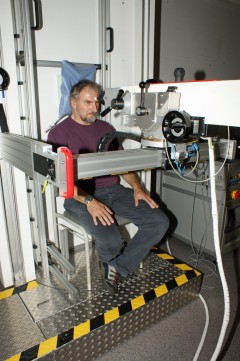- Artificial Intelligence (AI)
- Occupational exposure limit values
- Climate Change and Occupational Safety
- List of CMR substances
- Electromagnetic fields
- Ergonomics
- Industrial Security
- Collaborative robots
- Noise
- Nanoparticles at the workplace
- Optical Radiation
- REACH
- Reference materials
- Proficiency testing
- Vibration
- Virtual reality
- Work 4.0
Pain threshold map
The limit values for the total external force acting upon the human being and the local maximum pressure (effective pressure) in the collision plane have been set for the event of a collision between a human being and a robot at a collaborative workplace. The accepted strain limit for a given risk situation is defined by the pain threshold.
The pain threshold constitutes a physiological/psychological indicator of the onset of mechanical overload. It differs both from individual to individual and at different times for a specific individual. In this context, the pain threshold is therefore defined as the transition from the rising sense of pressure to the initial sense of pain, as a mental stress variable perceived and evaluated in the human brain. The pain threshold can be studied on a test subject collective in accordance with a defined stress/strain concept with the objective of determining forces and pressures. Limit values for use in standardization can be derived from the distributions.
In order to determine the force and pressure limits, the medical faculty of the Johannes Gutenberg University in Mainz is conducting DGUV research project FP 317 for creation of a human pain threshold map in conjunction with the IFA.
Creation of the pain threshold map
The pain threshold map is based upon a body model with 15 discrete regions of the body defined in the BG/BGIA recommendations: Design of workplaces with collaborative robots. Altogether, 29 body points were studied. They were fixed on seated or standing test subjects rigidly and with geometrical precision in a test jig by means of special positioning equipment, such as vacuum mattresses.
The pain thresholds were determined by means of pressure algometry. For this purpose, the IFA developed a test apparatus employing an automatic pressure algometer (see Figures 1 to 3). The test apparatus generated a stress which rose almost linearly up to the pain threshold (IFA projects IFA5113, 5114 and 5121). The rate of pressure rise was between 2 and 5 N/s. This enabled each test person to sense their own pain threshold precisely and reproducibly. The plunger employed featured a strongly rounded-off, square-section geometry with a base area of 14 × 14 mm. The test subject acknowledged attainment of the pain threshold by actuating a pushbutton.
A portal was used to set up the plunger tip of the pressure algometer optimally, with several mechanical degrees of freedom on all specified body points. During determining of the pain thresholds, the total external force in the plunger tip, the penetration distance in the deformed tissue and the pressure distribution in the contacting plunger plane were measured.
Evaluation and implementation
The high number of test subjects (approximately 100) enabled approximately 9,000 analyzable pain-threshold measurements to be obtained. The relevant factors influencing measurement were evaluated based upon a statistical analysis of the measured data. The project results are being channelled into standardization work currently being conducted on industrial robots, and collected in structured form and interpreted in an IFA database (IFA project IFA5111) containing human strain data of all degrees of severity and the associated causal boundary conditions.
The older limit values were obtained from literature studies and random laboratory tests. They represented guideline maximum stress levels for estimation of the severity of strain. The FP 317 project has delivered significant quasi-static force and pressure limits for the human pain threshold. These have been incorporated into recent standards (ISO/TS 15066, supplementing ISO 10218-2) and a DGUV informative publication on the use of collaborative robots. Besides the concrete values for validation of stresses during the risk assessment of workplaces involving collaborative robots, comprehensive observations were made concerning the medical stress limits in the region of the pain threshold.
For downloading

Rodday, V.; Geißler, B.; Ottersbach, H.J.; Huelke, M.; Letzel, S.; Muttray, A.: Druckschmerzschwellen bei Druckreizen. Mensch, Technik, Organisation – Vernetzung im Produktentstehungs- und -herstellungsprozess (PDF, 1.3 MB, non-accessible) . 57th conference of the Gesellschaft für Arbeitswissenschaft, 23-25 March 2011, Chemnitz
Further information

Project No. IFA5111: Development of a database of strain upon the body under exposure to acute mechanical exposure
Project No. IFA5113: Development of an algometer test facility for research projects in the area of the human-machine interface
Project No. IFA5114: Pain threshold map of the human body for the specification of limit values for machine guarding
Project No. IFA5121: Development and commissioning of a safety facility for the algometer test installation
Contact
Accident Prevention: Digitalisation - Technologies
Tel: +49 30 13001-3510Fax: +49 30 13001 38001


